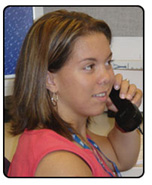Hearing Impairment: Advice From Kristin
When Kristin was just 18 months old, her parents found out she was partially deaf in both ears. Kristin is all grown up now. She graduated from college and is out on her own. Along the way, she overcame many obstacles and has some advice for kids who are hearing impaired — and for other kids who want to know what it's like to have trouble hearing.
Feeling Different
 Kindergarten was the first time I realized my hearing impairment made me different. After attending a school for the hearing impaired during my preschool years, my parents decided that I should go to kindergarten at a regular school. My teacher was nice, but I was the only student wearing hearing aids and an FM set (an amplification device that hung around my neck like a portable radio)
Kindergarten was the first time I realized my hearing impairment made me different. After attending a school for the hearing impaired during my preschool years, my parents decided that I should go to kindergarten at a regular school. My teacher was nice, but I was the only student wearing hearing aids and an FM set (an amplification device that hung around my neck like a portable radio)
At first, I just cried when the other kids asked me about my hearing problem. My mom saw that I was having difficulty explaining my impairment and told me that I shouldn't feel ashamed or embarrassed. She said the kids were only asking me because they didn't understand about my hearing problem or why I would miss school sometimes. I wasn't playing hooky — I was often visiting doctors or having surgeries.
I had 15 surgeries in all, but as I got older, I had fewer and fewer problems with my ears. And I learned to communicate so well that one of my high school teachers didn't realize I had hearing problems until the last day of class! I use only one hearing aid now and I have learned to read lips — to watch the way a person's mouth moves to understand what's being said.
Problems and Solutions
It has been a long road to get where I am today, but I did it. And if you have a hearing impairment, I want you to know that you can, too. Here is my best advice — both for kids who have hearing problems and kids who don't!
Problem: Trying to fit in with friends at school.
My advice: Help other kids understand hearing problems and what you're going through.
I have often found that kids are curious to know how a hearing aid works. A lot of kids in my class have jumped at the chance to try my hearing aid. Of course, it's not the best idea to share your hearing aid (also called an ear mold) with a bunch of people! It's a personal item, like a toothbrush. But you might be able to borrow or buy a special device that allows people to hear what you hear through your hearing aid. By letting your classmates hear what a hearing aid does, you're teaching them about hearing problems.
Here are some of the most commonly asked questions and how I would answer them:
Do you wear a hearing aid to bed?
Not usually, because it's uncomfortable. When I take it out, I put it in a desiccant, which is a dehumidifier to dry out the hearing aid. Sometimes, I forget though, and it gets misplaced. One morning I was late for my summer job because my cat was playing with my hearing aid and batted it down the stairs!
Can you get a hearing aid wet?
Definitely not. A hearing aid is a very expensive investment and can be easily ruined by water. I try hard not to get mine wet. At the beach, I sometimes stay close to shore and play in the surf so it doesn't get splashed. If I want to go swimming, I have to take it out.
What do you do when you play sports?
During some of my high school volleyball games I was inside a hot, stuffy gym and I got pretty sweaty. When I would make dives to save the ball, the momentum would make the sweat from my forehead seep into the hearing aid and cause it to malfunction temporarily. If it was raining during my outdoor soccer games, I would wear slip-on covers so my hearing aid would stay dry.
Problem: Getting teased.
My advice: Don't stoop to their level and seek help from an adult.
Even if you try to explain your problem, some kids won't get the message. Try not to let teasing get to you. I am a sensitive person so this was hard for me. I decided that I wouldn't return negative comments and that I'd get a grown-up to help me if it was getting out of hand.
Problem: Kids who don't have hearing problems sometimes don't know how to treat someone like me who does.
My advice: Try to understand what the hearing impaired person is going through.
 If you have difficulty understanding what a hearing impairment is, perhaps you could try on a pair of earplugs. They sell these at the drugstore and there's a kind that molds to the shape of your ear. Once you've put them in your ears, try to communicate with family and friends for a few hours. This may help you to be more patient and understanding to hearing impaired people. It can be frustrating and embarrassing when you don't understand what people are saying the first time.
If you have difficulty understanding what a hearing impairment is, perhaps you could try on a pair of earplugs. They sell these at the drugstore and there's a kind that molds to the shape of your ear. Once you've put them in your ears, try to communicate with family and friends for a few hours. This may help you to be more patient and understanding to hearing impaired people. It can be frustrating and embarrassing when you don't understand what people are saying the first time.
But there are a few advantages to having a hearing aid. When I am listening to my headphones on an airplane, all that I hear is my music, because I have a special feature on my hearing aid that blocks background noise, like the sound of the jet engine or other people talking. I can also use this feature when I talk on the telephone with a friend, so I hear only the person's voice.
However, there can be some disadvantages, too. For example, when I go into new situations and meet new people, I have to explain about my hearing impairment. I don't want it to get in the way or cause problems. When I went to college, I even bought an alarm clock that vibrates under my pillow, so I didn't disturb my college roommate! If I had used a regular alarm clock, I would have had to turn up the noise really loud.
I think my unusual alarm clock is a cool thing. I like being a little different from everyone else because I know that I am unique in my own way and my friends accept me for that. My advice to all kids is to be your own person. It's OK if you are not exactly like everyone else. In fact, your individuality can make you truly cool.
Reviewed by: Robert C. O'Reilly, MD
Date reviewed: March 2012
Note: All information is for educational purposes only. For specific medical advice, diagnoses, and treatment, consult your doctor.
© 1995-2024 KidsHealth ® All rights reserved. Images provided by iStock, Getty Images, Corbis, Veer, Science Photo Library, Science Source Images, Shutterstock, and Clipart.com


